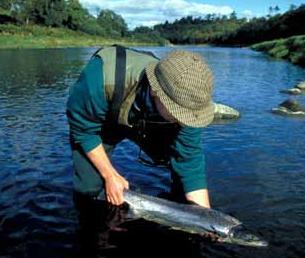Adaptation to support field sports (salmon fishing) on Scottish estates


From “Catch and Release: A Guide to Best Practice” by Marine Scotland
Summary
In the 1990s, the reduction in numbers of salmon observed in Scottish rivers was reviewed, notably by some estate managers and owners, and a voluntary procedure called ‘Catch and Release’ was implemented on these estates. Subsequently, this policy and its consequent effect on fish numbers was promulgated by Fishery Boards and taken up by other bodies responsible for fishery sustainability. At a national level, the effect of this policy appears to have been considerable.
Main messages
Adaptation of angling practice has seemingly had a large and positive effect on the number of salmon monitored in Scottish rivers. This ‘Catch and Release’ policy is a good example of a ‘bottom up’ approach to adaptation, borne out of local observation and desire to mitigate an undesirable trend in fish numbers which would pose a significant threat to Scottish estate sporting interests.
The issue
Atlantic salmon is one of Scotland’s most iconic species and is a high value natural asset. It provides a quality food product in a premium market and the basis of an economically important freshwater angling sector. However, there has been a global decline in abundance of Atlantic salmon stocks in the last 30-40 years, and Scotland has suffered in the reduction of salmon returning to its rivers to spawn. This decline is probably due to a number of factors, including: river pollution, man-made obstacles to migration upstream, disease and predation by non-native species, accidental netting at sea, and the effects of climate change both in the marine and fluvial environments.
Climate risks
In the marine environment, elevated temperature is suspected of affecting the timing of the planktonic ‘blooms’ required by young salmon. In the riparian environment, raised river temperature is also considered to be important, together with the increased turbidity and sedimentation as a result of run-off caused by increased rainfall events.
Main actions
The main action taken to mitigate the reduction in salmon numbers in Scottish rivers have been a voluntary ‘catch and release’ policy. This requires anglers to return salmon caught during recreational angling to the river and to modify practices such that the fish can recover and continue to swim upstream to spawn. This policy is an example of ‘bottom-up’ adaptation, originating on one or two Scottish estates, then promoted by bodies responsible for a sustainable salmon industry, followed by Government agencies such as Marine Scotland (Scotland) and the Environment Agency (England and Wales). In addition, tree planting in some Scottish riparian zones has taken place in order to help reduce direct sunlight and thus the temperature of stream and river water. This is likely to be extended.
Outcomes
The application of the range of adaptation measures discussed in Scotland’s “Strategic Framework for Scottish Freshwater Fisheries” has had a very positive effect on the numbers of Salmon monitored in Scottish rivers.
Lessons learnt
Catch and release has proven successful. It is a good example of an adaptation measure where there has been an immediate response and thus a commercial ‘pay-back’ for those estates who have adopted it. Nevertheless, it remains a voluntary measure and is therefore dependent on individual acceptance, together with local supervision and control from estate ghillies and others responsible for angling practices. It remains to be seen to what extent catch and release alone can continue to sustain salmon populations in Scottish rivers, but government policy is to promote a multi-tiered approach. In addition, there is a considerable Scottish research programme to develop a better understanding of the impact of climate change.
Role of Policy and Decision Makers
The possible effect of Catch and Release through moderation of salmon numbers requires formal monitoring and scientific analysis from a responsible body. Results of monitoring should be published annually. Guidance on best practice for Catch and Release should be made available on appropriate public websites. Consideration should be given to the need for training in fish release techniques, notably to estate ghillies, from appropriate responsible bodies.
Key messages for Policy and Decision Makers
Marine Scotland: continue to collect monitoring data on salmon occurrence in Scottish rivers and evaluate in context of climate change and other impacts. Gather information on the application of ‘Catch and release’. Continue to communicate the benefits of catch and release to Salmon Boards, river managers and the angling sector.
Scottish Government climate change policy makers: take stock of work undertaken by Marine Scotland and include information as part of formal indicators of Scottish adaptation (e.g. to input into five yearly Climate Change Risk Assessments for Scotland).
Forestry Commission Scotland: continue to support research on the effect of trees on riparian environments, and ensure that financial instruments (e.g. Planning Grants for woodland creation) are suitable for promoting woodland planting.
- Riparian tree planting (picture)
- Put them back- Catch and release guidelines: How anglers can help conserve the salmon stocks of England and Wales
- Salmon and climate hange: Fish in hot water
- Keeping Rivers Cool: Getting ready for climate change by creating riparian shade (Environment Agency)
- Catch and release: a guide to best practice by Marine Scotland
- Effect of climate change on salmon fisheries
- Atlantic Salmon Threats (2010): A three page summary by the Atlantic Salmon Trust of threats to Atlantic Salmon
(0) Comments
There is no content